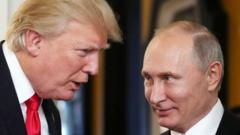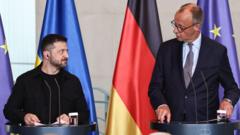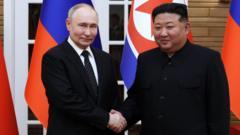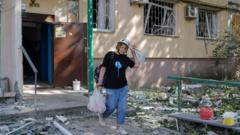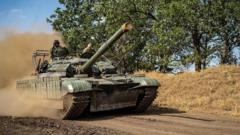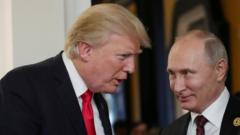The upcoming Alaska summit raises questions about potential territorial negotiations between Russia and Ukraine, further complicating an already tense situation as Ukraine fights to maintain its sovereignty.
**Possible Outcomes of the Trump-Putin Summit: Territorial Swaps and Ukraine’s Future**
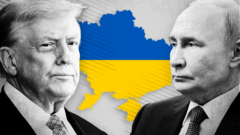
**Possible Outcomes of the Trump-Putin Summit: Territorial Swaps and Ukraine’s Future**
Speculation grows over the implications of the Trump-Putin meeting for Ukraine amidst ongoing territorial disputes.
In maps: The war-torn landscape of Ukraine draws new attention as former President Donald Trump prepares for his highly anticipated summit with Vladimir Putin in Alaska this Friday. As both leaders meet, there is increasing speculation that the discussions could radically alter the geopolitical map of Ukraine, a country embroiled in conflict since 2014.
Following Russia's initial annexation of Crimea, an aggressive campaign unfolded in eastern Ukraine, particularly in the Donbas region. Cities within the Donetsk and Luhansk oblasts have endured years of fighting, marked by an eight-year struggle that cost Ukraine around 14,000 military and civilian lives prior to the major escalation in 2022.
The conflict took a drastic turn when Putin launched a full-scale invasion in February 2022, leading to rapid territorial gains for Russian forces. At one point, Russia controlled up to 27% of Ukrainian territory, though that figure has since decreased to around 20%. In recent weeks, President Volodymyr Zelensky has urged for an unconditional ceasefire amid ongoing pressure from European allies. However, Trump's recent statements have deviated towards the notion of territorial swaps, sparking apprehension in Kyiv.
Uncertainties loom over what specific territories Trump envisions for potential exchanges, especially given that all disputed lands are recognized as part of Ukraine. Reports have surfaced indicating that Putin seeks to solidify Russian control over Luhansk and Donetsk, creating further doubts about Ukraine ceding territory that has claimed numerous Ukrainian lives in defense.
Currently, Russia seems to be pushing for significant advantages in the Donetsk region, potentially to illustrate its dominance in the lead-up to the summit. Areas such as Zaporizhzhia and Kherson, captured in the wake of the 2022 invasion, remain contentious, with some reports suggesting Russia may be willing to freeze combat operations, though returning territory still appears unlikely.
Trump’s vague allusions to "ocean-front property" have stirred further confusion regarding which lands may be considered for exchange. This pertains especially to coastline along the critical Sea of Azov and Black Sea, which Russia perceives as a vital connection to its annexed territories in Crimea.
As these discussions develop, the Ukrainian government remains steadfast that any concessions on territorial integrity are unacceptable. For Europe and Ukraine alike, thoughts of territorial swaps signal a potential betrayal of the sacrifices made by countless soldiers and civilians. The future of the region's borders and Ukraine's sovereignty may ultimately hinge on both the outcome of this summit and a peaceful resolution to the ongoing conflict.
Following Russia's initial annexation of Crimea, an aggressive campaign unfolded in eastern Ukraine, particularly in the Donbas region. Cities within the Donetsk and Luhansk oblasts have endured years of fighting, marked by an eight-year struggle that cost Ukraine around 14,000 military and civilian lives prior to the major escalation in 2022.
The conflict took a drastic turn when Putin launched a full-scale invasion in February 2022, leading to rapid territorial gains for Russian forces. At one point, Russia controlled up to 27% of Ukrainian territory, though that figure has since decreased to around 20%. In recent weeks, President Volodymyr Zelensky has urged for an unconditional ceasefire amid ongoing pressure from European allies. However, Trump's recent statements have deviated towards the notion of territorial swaps, sparking apprehension in Kyiv.
Uncertainties loom over what specific territories Trump envisions for potential exchanges, especially given that all disputed lands are recognized as part of Ukraine. Reports have surfaced indicating that Putin seeks to solidify Russian control over Luhansk and Donetsk, creating further doubts about Ukraine ceding territory that has claimed numerous Ukrainian lives in defense.
Currently, Russia seems to be pushing for significant advantages in the Donetsk region, potentially to illustrate its dominance in the lead-up to the summit. Areas such as Zaporizhzhia and Kherson, captured in the wake of the 2022 invasion, remain contentious, with some reports suggesting Russia may be willing to freeze combat operations, though returning territory still appears unlikely.
Trump’s vague allusions to "ocean-front property" have stirred further confusion regarding which lands may be considered for exchange. This pertains especially to coastline along the critical Sea of Azov and Black Sea, which Russia perceives as a vital connection to its annexed territories in Crimea.
As these discussions develop, the Ukrainian government remains steadfast that any concessions on territorial integrity are unacceptable. For Europe and Ukraine alike, thoughts of territorial swaps signal a potential betrayal of the sacrifices made by countless soldiers and civilians. The future of the region's borders and Ukraine's sovereignty may ultimately hinge on both the outcome of this summit and a peaceful resolution to the ongoing conflict.

